Physics Part 2 Final Exam Covering Waves, Optics, and Electromagnetism
VerifiedAdded on 2022/09/06
|23
|3842
|158
Homework Assignment
AI Summary
This document contains the solutions to a Physics Part 2 final exam, addressing a wide range of topics in waves, optics, and electromagnetism. The solutions cover concepts such as constructive and destructive interference, the characteristics of surface waves, wave period calculations, the Doppler effect, and the behavior of musical instruments. Furthermore, the document explores topics in optics including reflection, refraction, diffraction, and the properties of mirrors and lenses. It also includes problems related to electric charges, conductors, insulators, and the behavior of charged objects. The solutions provide detailed explanations, calculations, and diagrams to aid in understanding the concepts.
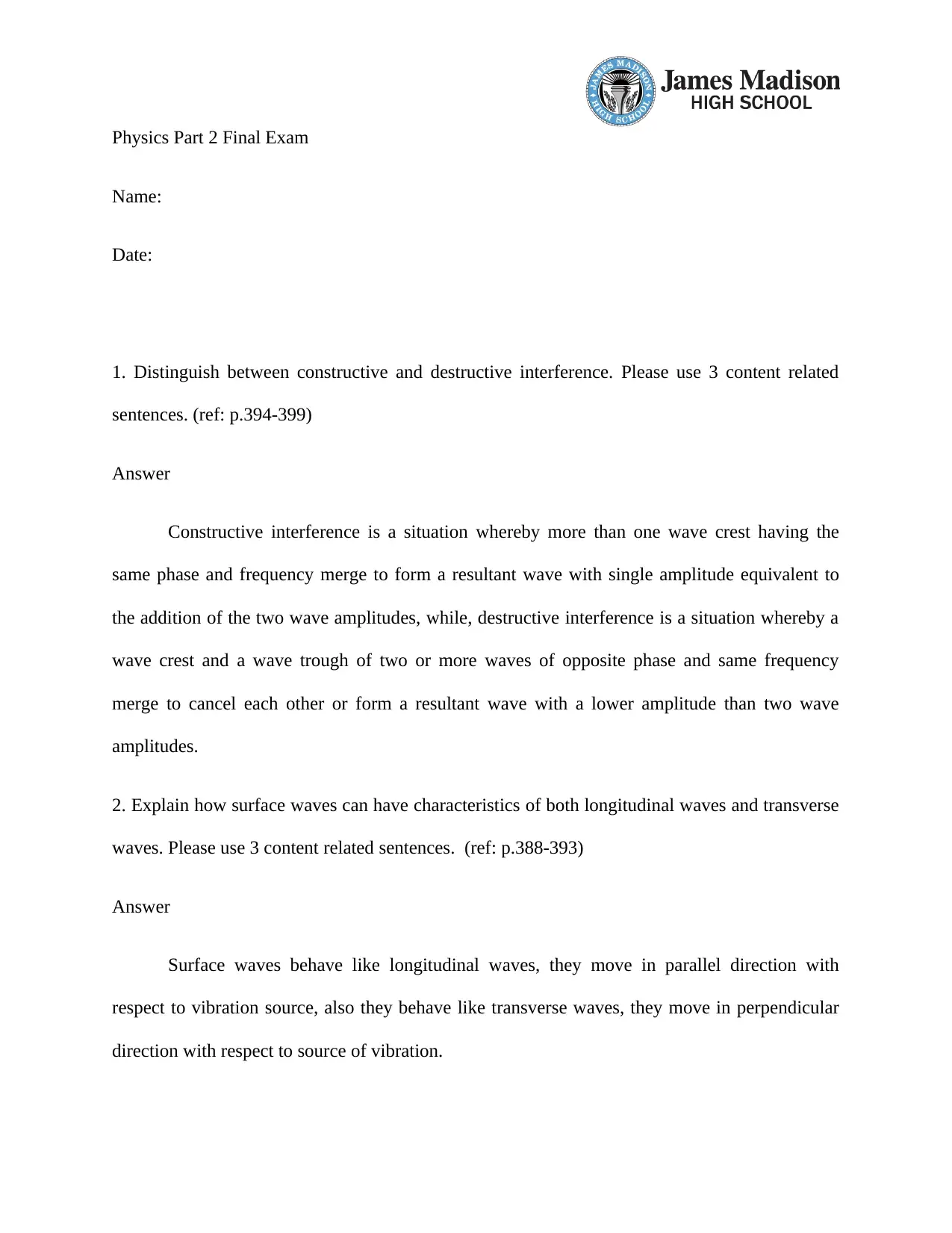
Physics Part 2 Final Exam
Name:
Date:
1. Distinguish between constructive and destructive interference. Please use 3 content related
sentences. (ref: p.394-399)
Answer
Constructive interference is a situation whereby more than one wave crest having the
same phase and frequency merge to form a resultant wave with single amplitude equivalent to
the addition of the two wave amplitudes, while, destructive interference is a situation whereby a
wave crest and a wave trough of two or more waves of opposite phase and same frequency
merge to cancel each other or form a resultant wave with a lower amplitude than two wave
amplitudes.
2. Explain how surface waves can have characteristics of both longitudinal waves and transverse
waves. Please use 3 content related sentences. (ref: p.388-393)
Answer
Surface waves behave like longitudinal waves, they move in parallel direction with
respect to vibration source, also they behave like transverse waves, they move in perpendicular
direction with respect to source of vibration.
Name:
Date:
1. Distinguish between constructive and destructive interference. Please use 3 content related
sentences. (ref: p.394-399)
Answer
Constructive interference is a situation whereby more than one wave crest having the
same phase and frequency merge to form a resultant wave with single amplitude equivalent to
the addition of the two wave amplitudes, while, destructive interference is a situation whereby a
wave crest and a wave trough of two or more waves of opposite phase and same frequency
merge to cancel each other or form a resultant wave with a lower amplitude than two wave
amplitudes.
2. Explain how surface waves can have characteristics of both longitudinal waves and transverse
waves. Please use 3 content related sentences. (ref: p.388-393)
Answer
Surface waves behave like longitudinal waves, they move in parallel direction with
respect to vibration source, also they behave like transverse waves, they move in perpendicular
direction with respect to source of vibration.
Paraphrase This Document
Need a fresh take? Get an instant paraphrase of this document with our AI Paraphraser
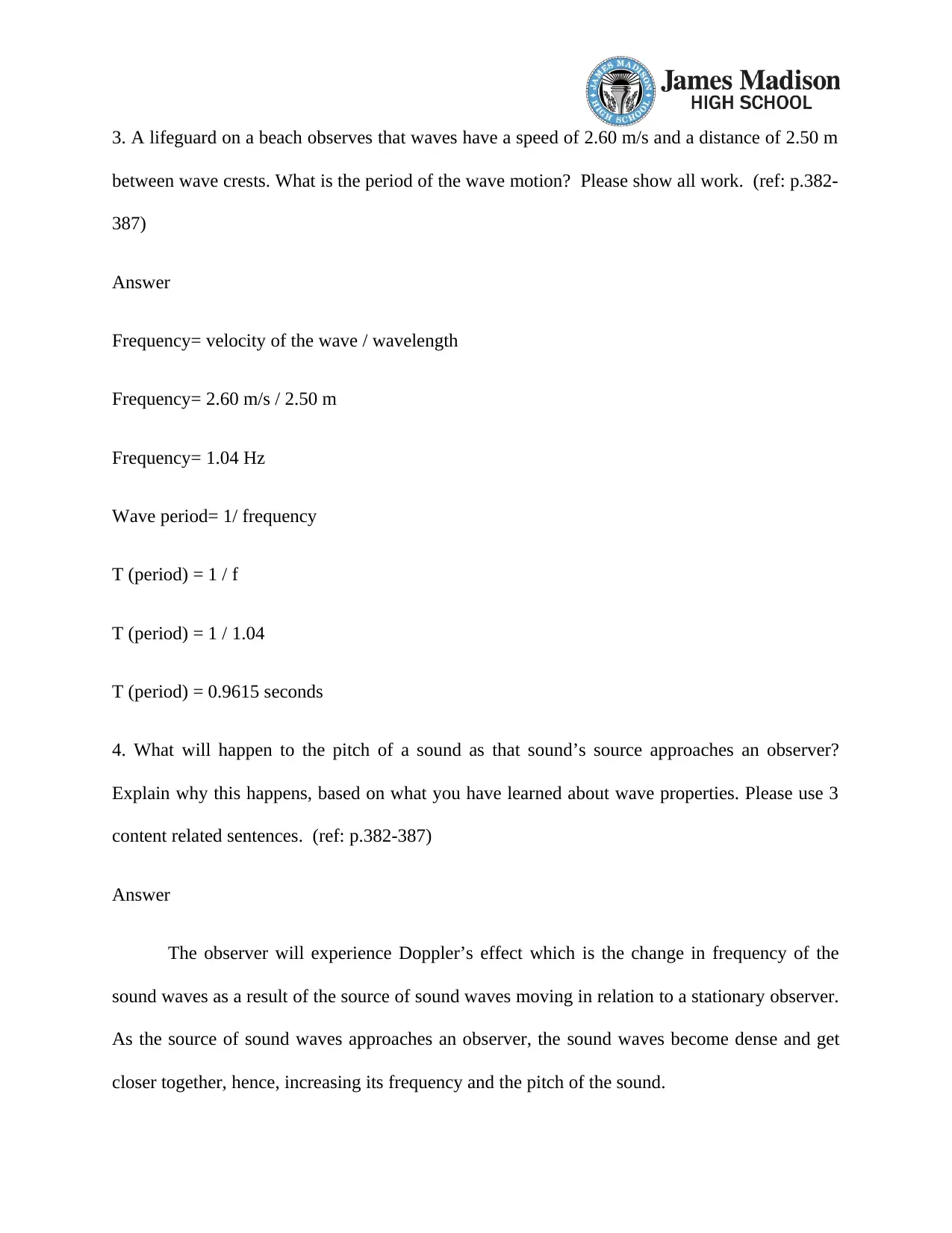
3. A lifeguard on a beach observes that waves have a speed of 2.60 m/s and a distance of 2.50 m
between wave crests. What is the period of the wave motion? Please show all work. (ref: p.382-
387)
Answer
Frequency= velocity of the wave / wavelength
Frequency= 2.60 m/s / 2.50 m
Frequency= 1.04 Hz
Wave period= 1/ frequency
T (period) = 1 / f
T (period) = 1 / 1.04
T (period) = 0.9615 seconds
4. What will happen to the pitch of a sound as that sound’s source approaches an observer?
Explain why this happens, based on what you have learned about wave properties. Please use 3
content related sentences. (ref: p.382-387)
Answer
The observer will experience Doppler’s effect which is the change in frequency of the
sound waves as a result of the source of sound waves moving in relation to a stationary observer.
As the source of sound waves approaches an observer, the sound waves become dense and get
closer together, hence, increasing its frequency and the pitch of the sound.
between wave crests. What is the period of the wave motion? Please show all work. (ref: p.382-
387)
Answer
Frequency= velocity of the wave / wavelength
Frequency= 2.60 m/s / 2.50 m
Frequency= 1.04 Hz
Wave period= 1/ frequency
T (period) = 1 / f
T (period) = 1 / 1.04
T (period) = 0.9615 seconds
4. What will happen to the pitch of a sound as that sound’s source approaches an observer?
Explain why this happens, based on what you have learned about wave properties. Please use 3
content related sentences. (ref: p.382-387)
Answer
The observer will experience Doppler’s effect which is the change in frequency of the
sound waves as a result of the source of sound waves moving in relation to a stationary observer.
As the source of sound waves approaches an observer, the sound waves become dense and get
closer together, hence, increasing its frequency and the pitch of the sound.
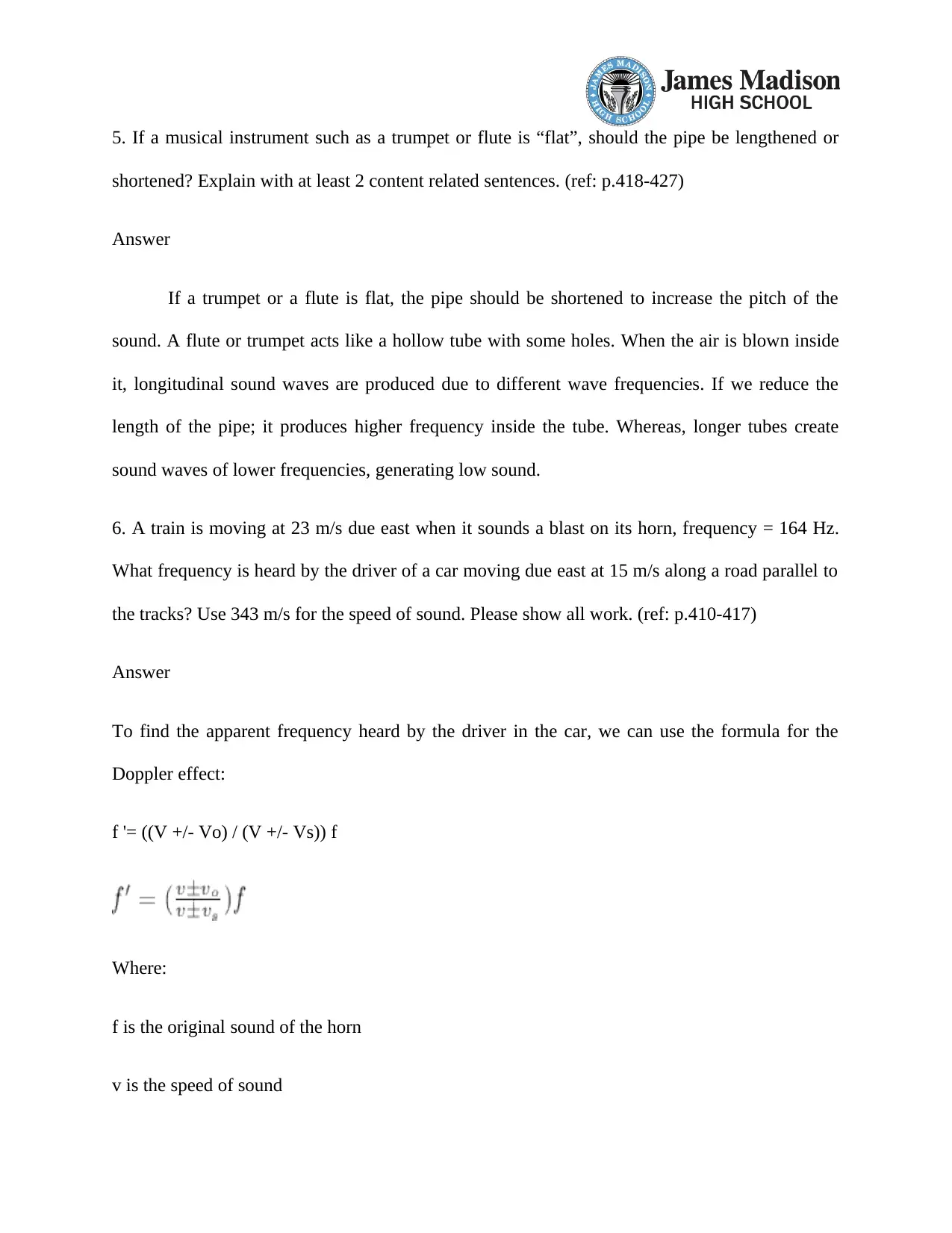
5. If a musical instrument such as a trumpet or flute is “flat”, should the pipe be lengthened or
shortened? Explain with at least 2 content related sentences. (ref: p.418-427)
Answer
If a trumpet or a flute is flat, the pipe should be shortened to increase the pitch of the
sound. A flute or trumpet acts like a hollow tube with some holes. When the air is blown inside
it, longitudinal sound waves are produced due to different wave frequencies. If we reduce the
length of the pipe; it produces higher frequency inside the tube. Whereas, longer tubes create
sound waves of lower frequencies, generating low sound.
6. A train is moving at 23 m/s due east when it sounds a blast on its horn, frequency = 164 Hz.
What frequency is heard by the driver of a car moving due east at 15 m/s along a road parallel to
the tracks? Use 343 m/s for the speed of sound. Please show all work. (ref: p.410-417)
Answer
To find the apparent frequency heard by the driver in the car, we can use the formula for the
Doppler effect:
f '= ((V +/- Vo) / (V +/- Vs)) f
Where:
f is the original sound of the horn
v is the speed of sound
shortened? Explain with at least 2 content related sentences. (ref: p.418-427)
Answer
If a trumpet or a flute is flat, the pipe should be shortened to increase the pitch of the
sound. A flute or trumpet acts like a hollow tube with some holes. When the air is blown inside
it, longitudinal sound waves are produced due to different wave frequencies. If we reduce the
length of the pipe; it produces higher frequency inside the tube. Whereas, longer tubes create
sound waves of lower frequencies, generating low sound.
6. A train is moving at 23 m/s due east when it sounds a blast on its horn, frequency = 164 Hz.
What frequency is heard by the driver of a car moving due east at 15 m/s along a road parallel to
the tracks? Use 343 m/s for the speed of sound. Please show all work. (ref: p.410-417)
Answer
To find the apparent frequency heard by the driver in the car, we can use the formula for the
Doppler effect:
f '= ((V +/- Vo) / (V +/- Vs)) f
Where:
f is the original sound of the horn
v is the speed of sound
⊘ This is a preview!⊘
Do you want full access?
Subscribe today to unlock all pages.

Trusted by 1+ million students worldwide
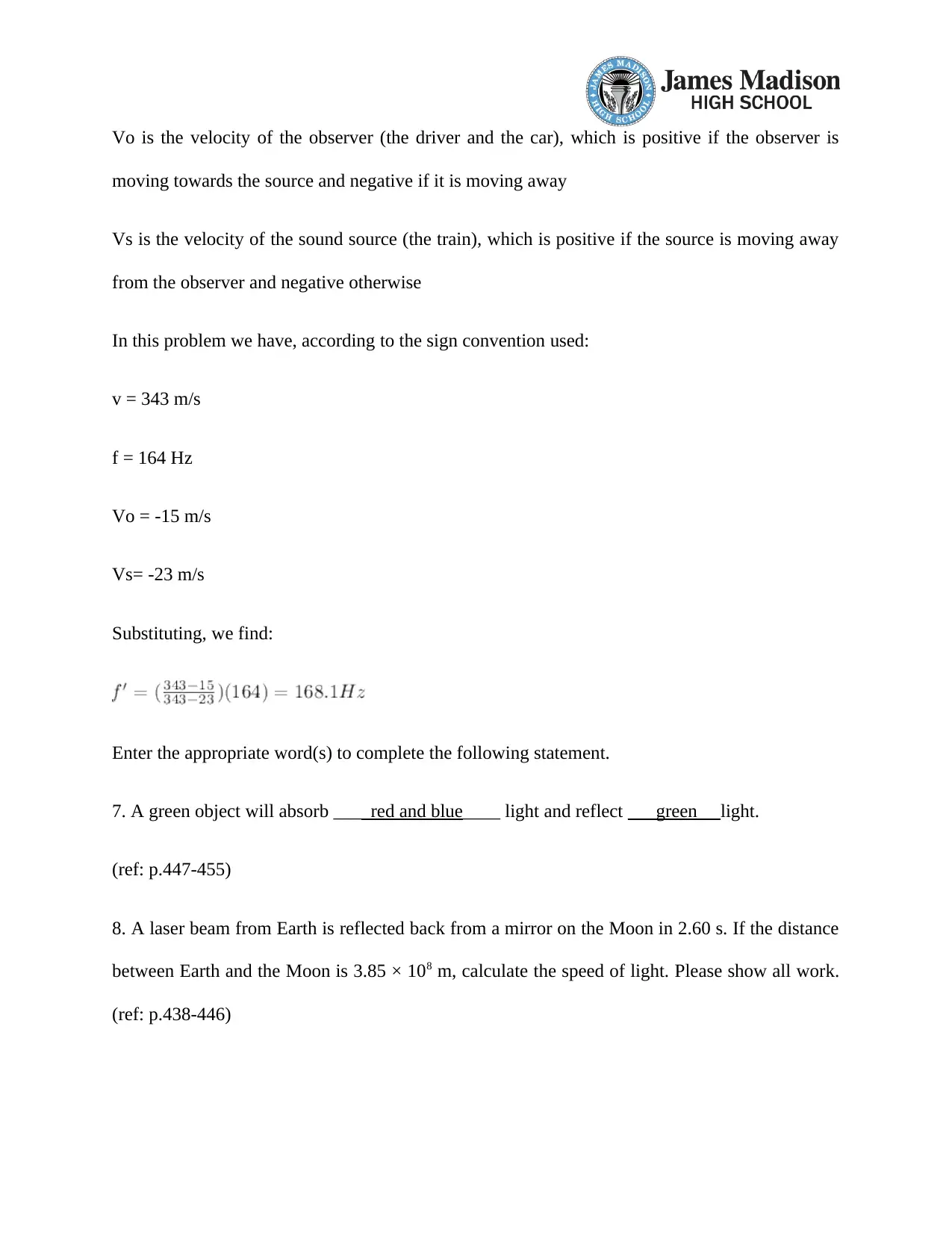
Vo is the velocity of the observer (the driver and the car), which is positive if the observer is
moving towards the source and negative if it is moving away
Vs is the velocity of the sound source (the train), which is positive if the source is moving away
from the observer and negative otherwise
In this problem we have, according to the sign convention used:
v = 343 m/s
f = 164 Hz
Vo = -15 m/s
Vs= -23 m/s
Substituting, we find:
Enter the appropriate word(s) to complete the following statement.
7. A green object will absorb ____red and blue____ light and reflect _ green light.
(ref: p.447-455)
8. A laser beam from Earth is reflected back from a mirror on the Moon in 2.60 s. If the distance
between Earth and the Moon is 3.85 × 108 m, calculate the speed of light. Please show all work.
(ref: p.438-446)
moving towards the source and negative if it is moving away
Vs is the velocity of the sound source (the train), which is positive if the source is moving away
from the observer and negative otherwise
In this problem we have, according to the sign convention used:
v = 343 m/s
f = 164 Hz
Vo = -15 m/s
Vs= -23 m/s
Substituting, we find:
Enter the appropriate word(s) to complete the following statement.
7. A green object will absorb ____red and blue____ light and reflect _ green light.
(ref: p.447-455)
8. A laser beam from Earth is reflected back from a mirror on the Moon in 2.60 s. If the distance
between Earth and the Moon is 3.85 × 108 m, calculate the speed of light. Please show all work.
(ref: p.438-446)
Paraphrase This Document
Need a fresh take? Get an instant paraphrase of this document with our AI Paraphraser
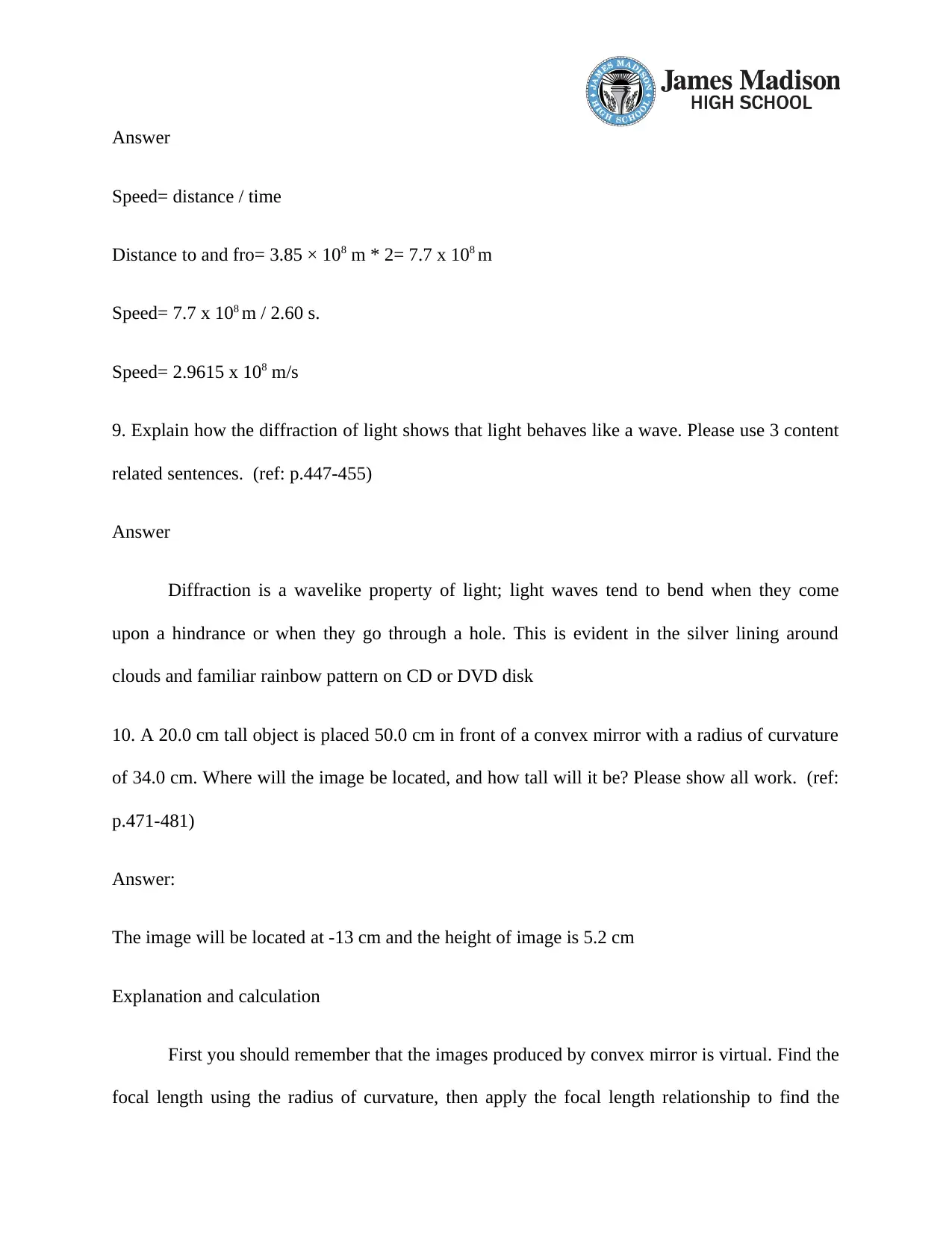
Answer
Speed= distance / time
Distance to and fro= 3.85 × 108 m * 2= 7.7 x 108 m
Speed= 7.7 x 108 m / 2.60 s.
Speed= 2.9615 x 108 m/s
9. Explain how the diffraction of light shows that light behaves like a wave. Please use 3 content
related sentences. (ref: p.447-455)
Answer
Diffraction is a wavelike property of light; light waves tend to bend when they come
upon a hindrance or when they go through a hole. This is evident in the silver lining around
clouds and familiar rainbow pattern on CD or DVD disk
10. A 20.0 cm tall object is placed 50.0 cm in front of a convex mirror with a radius of curvature
of 34.0 cm. Where will the image be located, and how tall will it be? Please show all work. (ref:
p.471-481)
Answer:
The image will be located at -13 cm and the height of image is 5.2 cm
Explanation and calculation
First you should remember that the images produced by convex mirror is virtual. Find the
focal length using the radius of curvature, then apply the focal length relationship to find the
Speed= distance / time
Distance to and fro= 3.85 × 108 m * 2= 7.7 x 108 m
Speed= 7.7 x 108 m / 2.60 s.
Speed= 2.9615 x 108 m/s
9. Explain how the diffraction of light shows that light behaves like a wave. Please use 3 content
related sentences. (ref: p.447-455)
Answer
Diffraction is a wavelike property of light; light waves tend to bend when they come
upon a hindrance or when they go through a hole. This is evident in the silver lining around
clouds and familiar rainbow pattern on CD or DVD disk
10. A 20.0 cm tall object is placed 50.0 cm in front of a convex mirror with a radius of curvature
of 34.0 cm. Where will the image be located, and how tall will it be? Please show all work. (ref:
p.471-481)
Answer:
The image will be located at -13 cm and the height of image is 5.2 cm
Explanation and calculation
First you should remember that the images produced by convex mirror is virtual. Find the
focal length using the radius of curvature, then apply the focal length relationship to find the
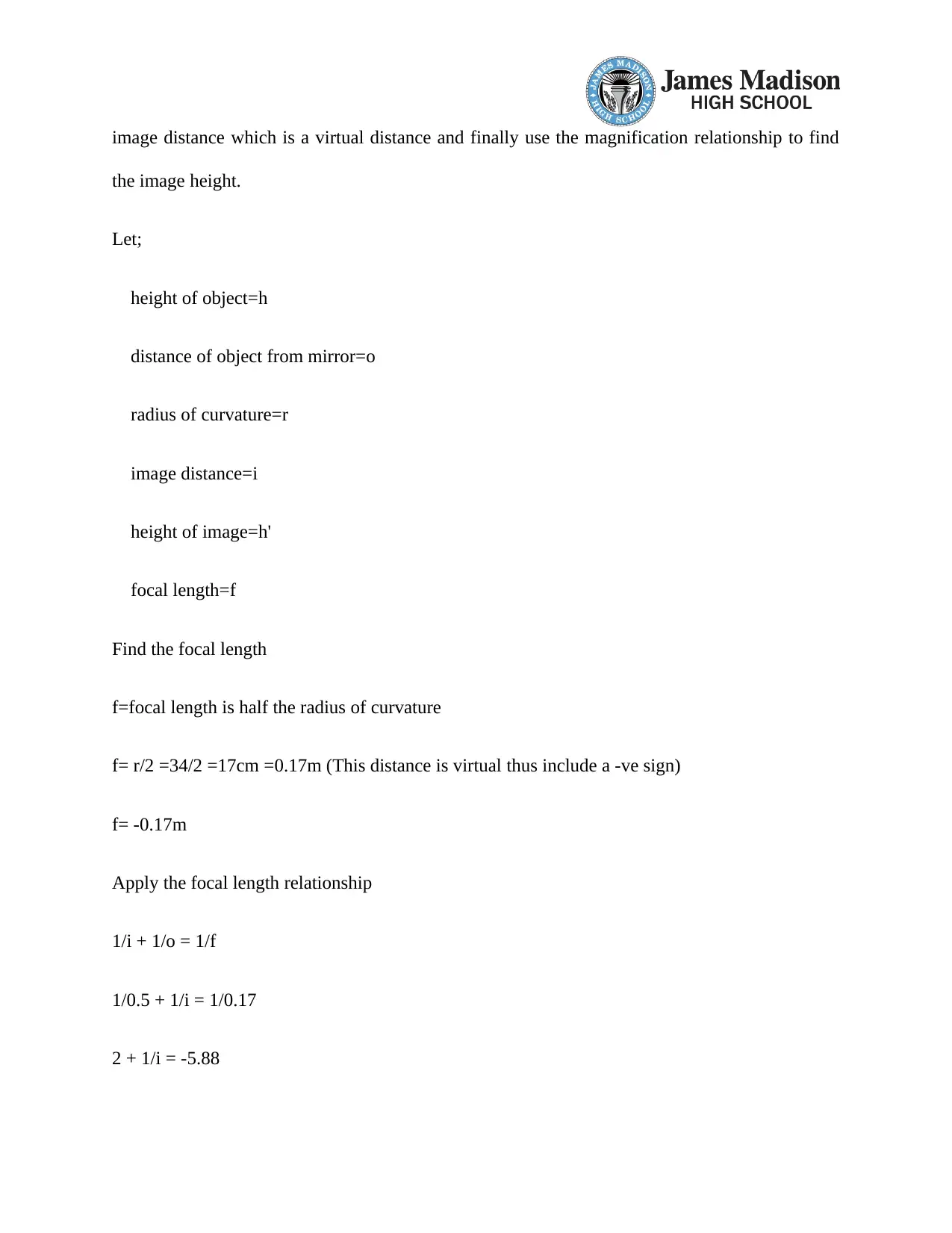
image distance which is a virtual distance and finally use the magnification relationship to find
the image height.
Let;
height of object=h
distance of object from mirror=o
radius of curvature=r
image distance=i
height of image=h'
focal length=f
Find the focal length
f=focal length is half the radius of curvature
f= r/2 =34/2 =17cm =0.17m (This distance is virtual thus include a -ve sign)
f= -0.17m
Apply the focal length relationship
1/i + 1/o = 1/f
1/0.5 + 1/i = 1/0.17
2 + 1/i = -5.88
the image height.
Let;
height of object=h
distance of object from mirror=o
radius of curvature=r
image distance=i
height of image=h'
focal length=f
Find the focal length
f=focal length is half the radius of curvature
f= r/2 =34/2 =17cm =0.17m (This distance is virtual thus include a -ve sign)
f= -0.17m
Apply the focal length relationship
1/i + 1/o = 1/f
1/0.5 + 1/i = 1/0.17
2 + 1/i = -5.88
⊘ This is a preview!⊘
Do you want full access?
Subscribe today to unlock all pages.

Trusted by 1+ million students worldwide
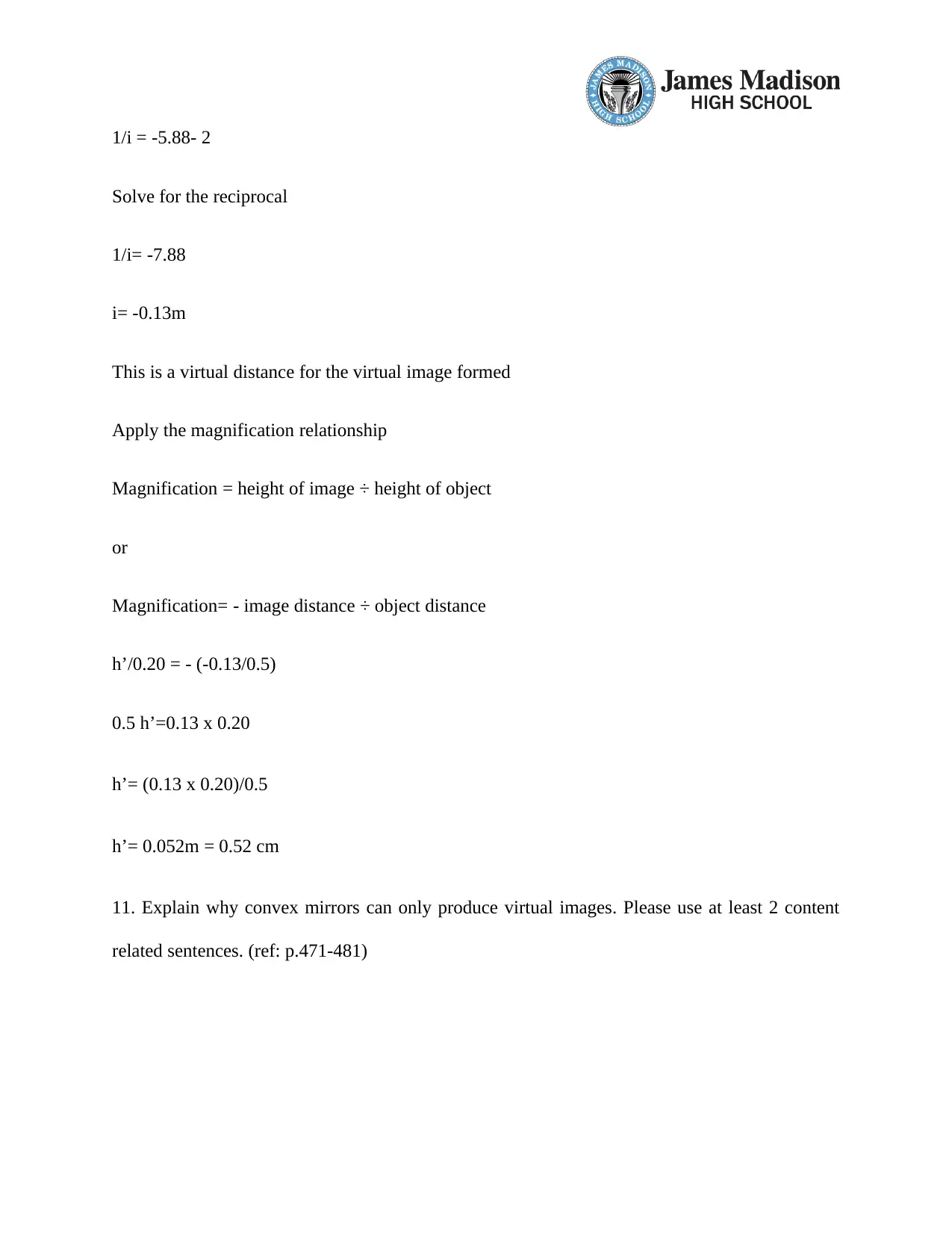
1/i = -5.88- 2
Solve for the reciprocal
1/i= -7.88
i= -0.13m
This is a virtual distance for the virtual image formed
Apply the magnification relationship
Magnification = height of image ÷ height of object
or
Magnification= - image distance ÷ object distance
h’/0.20 = - (-0.13/0.5)
0.5 h’=0.13 x 0.20
h’= (0.13 x 0.20)/0.5
h’= 0.052m = 0.52 cm
11. Explain why convex mirrors can only produce virtual images. Please use at least 2 content
related sentences. (ref: p.471-481)
Solve for the reciprocal
1/i= -7.88
i= -0.13m
This is a virtual distance for the virtual image formed
Apply the magnification relationship
Magnification = height of image ÷ height of object
or
Magnification= - image distance ÷ object distance
h’/0.20 = - (-0.13/0.5)
0.5 h’=0.13 x 0.20
h’= (0.13 x 0.20)/0.5
h’= 0.052m = 0.52 cm
11. Explain why convex mirrors can only produce virtual images. Please use at least 2 content
related sentences. (ref: p.471-481)
Paraphrase This Document
Need a fresh take? Get an instant paraphrase of this document with our AI Paraphraser
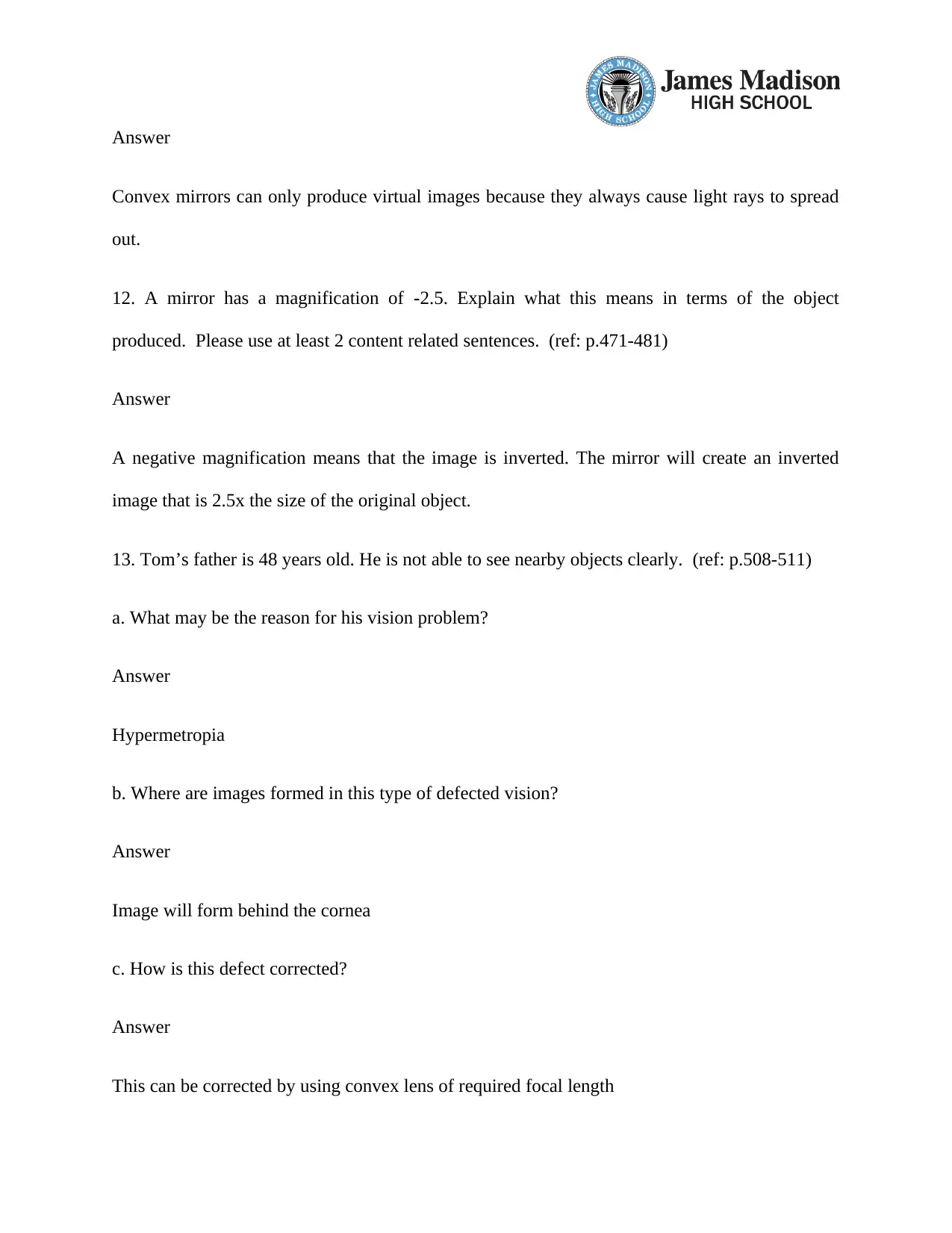
Answer
Convex mirrors can only produce virtual images because they always cause light rays to spread
out.
12. A mirror has a magnification of -2.5. Explain what this means in terms of the object
produced. Please use at least 2 content related sentences. (ref: p.471-481)
Answer
A negative magnification means that the image is inverted. The mirror will create an inverted
image that is 2.5x the size of the original object.
13. Tom’s father is 48 years old. He is not able to see nearby objects clearly. (ref: p.508-511)
a. What may be the reason for his vision problem?
Answer
Hypermetropia
b. Where are images formed in this type of defected vision?
Answer
Image will form behind the cornea
c. How is this defect corrected?
Answer
This can be corrected by using convex lens of required focal length
Convex mirrors can only produce virtual images because they always cause light rays to spread
out.
12. A mirror has a magnification of -2.5. Explain what this means in terms of the object
produced. Please use at least 2 content related sentences. (ref: p.471-481)
Answer
A negative magnification means that the image is inverted. The mirror will create an inverted
image that is 2.5x the size of the original object.
13. Tom’s father is 48 years old. He is not able to see nearby objects clearly. (ref: p.508-511)
a. What may be the reason for his vision problem?
Answer
Hypermetropia
b. Where are images formed in this type of defected vision?
Answer
Image will form behind the cornea
c. How is this defect corrected?
Answer
This can be corrected by using convex lens of required focal length
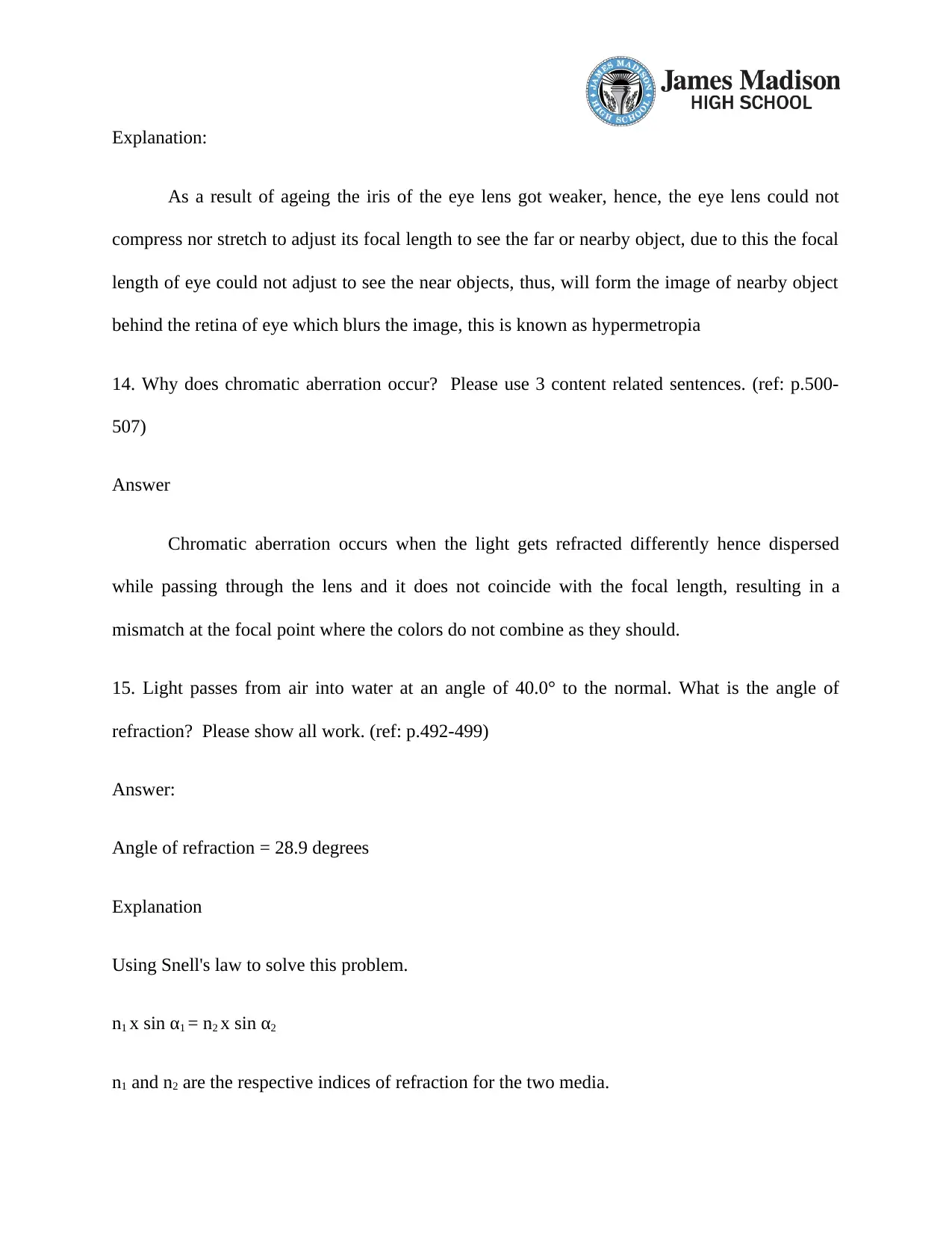
Explanation:
As a result of ageing the iris of the eye lens got weaker, hence, the eye lens could not
compress nor stretch to adjust its focal length to see the far or nearby object, due to this the focal
length of eye could not adjust to see the near objects, thus, will form the image of nearby object
behind the retina of eye which blurs the image, this is known as hypermetropia
14. Why does chromatic aberration occur? Please use 3 content related sentences. (ref: p.500-
507)
Answer
Chromatic aberration occurs when the light gets refracted differently hence dispersed
while passing through the lens and it does not coincide with the focal length, resulting in a
mismatch at the focal point where the colors do not combine as they should.
15. Light passes from air into water at an angle of 40.0° to the normal. What is the angle of
refraction? Please show all work. (ref: p.492-499)
Answer:
Angle of refraction = 28.9 degrees
Explanation
Using Snell's law to solve this problem.
n1 x sin α1 = n2 x sin α2
n1 and n2 are the respective indices of refraction for the two media.
As a result of ageing the iris of the eye lens got weaker, hence, the eye lens could not
compress nor stretch to adjust its focal length to see the far or nearby object, due to this the focal
length of eye could not adjust to see the near objects, thus, will form the image of nearby object
behind the retina of eye which blurs the image, this is known as hypermetropia
14. Why does chromatic aberration occur? Please use 3 content related sentences. (ref: p.500-
507)
Answer
Chromatic aberration occurs when the light gets refracted differently hence dispersed
while passing through the lens and it does not coincide with the focal length, resulting in a
mismatch at the focal point where the colors do not combine as they should.
15. Light passes from air into water at an angle of 40.0° to the normal. What is the angle of
refraction? Please show all work. (ref: p.492-499)
Answer:
Angle of refraction = 28.9 degrees
Explanation
Using Snell's law to solve this problem.
n1 x sin α1 = n2 x sin α2
n1 and n2 are the respective indices of refraction for the two media.
⊘ This is a preview!⊘
Do you want full access?
Subscribe today to unlock all pages.

Trusted by 1+ million students worldwide
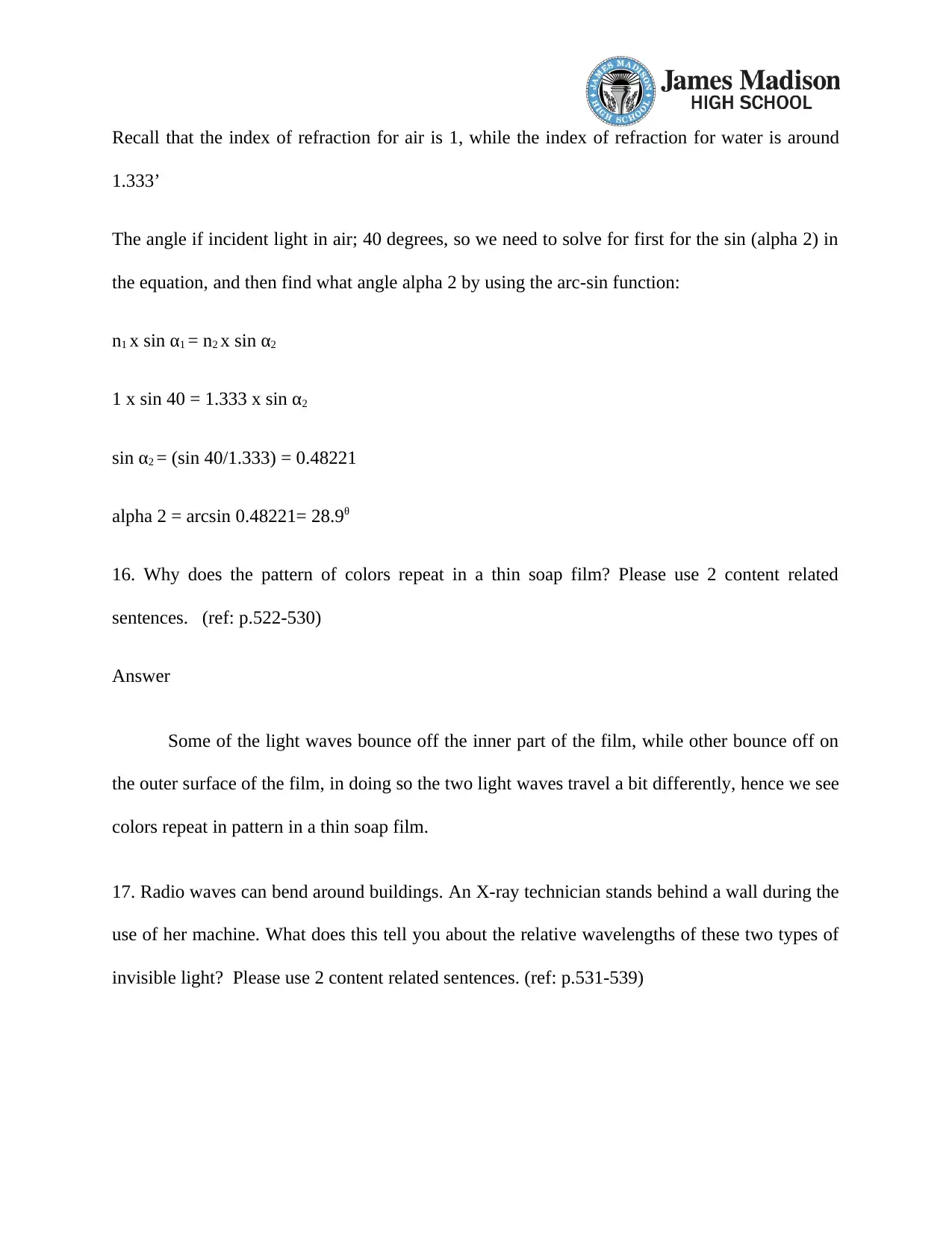
Recall that the index of refraction for air is 1, while the index of refraction for water is around
1.333’
The angle if incident light in air; 40 degrees, so we need to solve for first for the sin (alpha 2) in
the equation, and then find what angle alpha 2 by using the arc-sin function:
n1 x sin α1 = n2 x sin α2
1 x sin 40 = 1.333 x sin α2
sin α2 = (sin 40/1.333) = 0.48221
alpha 2 = arcsin 0.48221= 28.9θ
16. Why does the pattern of colors repeat in a thin soap film? Please use 2 content related
sentences. (ref: p.522-530)
Answer
Some of the light waves bounce off the inner part of the film, while other bounce off on
the outer surface of the film, in doing so the two light waves travel a bit differently, hence we see
colors repeat in pattern in a thin soap film.
17. Radio waves can bend around buildings. An X-ray technician stands behind a wall during the
use of her machine. What does this tell you about the relative wavelengths of these two types of
invisible light? Please use 2 content related sentences. (ref: p.531-539)
1.333’
The angle if incident light in air; 40 degrees, so we need to solve for first for the sin (alpha 2) in
the equation, and then find what angle alpha 2 by using the arc-sin function:
n1 x sin α1 = n2 x sin α2
1 x sin 40 = 1.333 x sin α2
sin α2 = (sin 40/1.333) = 0.48221
alpha 2 = arcsin 0.48221= 28.9θ
16. Why does the pattern of colors repeat in a thin soap film? Please use 2 content related
sentences. (ref: p.522-530)
Answer
Some of the light waves bounce off the inner part of the film, while other bounce off on
the outer surface of the film, in doing so the two light waves travel a bit differently, hence we see
colors repeat in pattern in a thin soap film.
17. Radio waves can bend around buildings. An X-ray technician stands behind a wall during the
use of her machine. What does this tell you about the relative wavelengths of these two types of
invisible light? Please use 2 content related sentences. (ref: p.531-539)
Paraphrase This Document
Need a fresh take? Get an instant paraphrase of this document with our AI Paraphraser
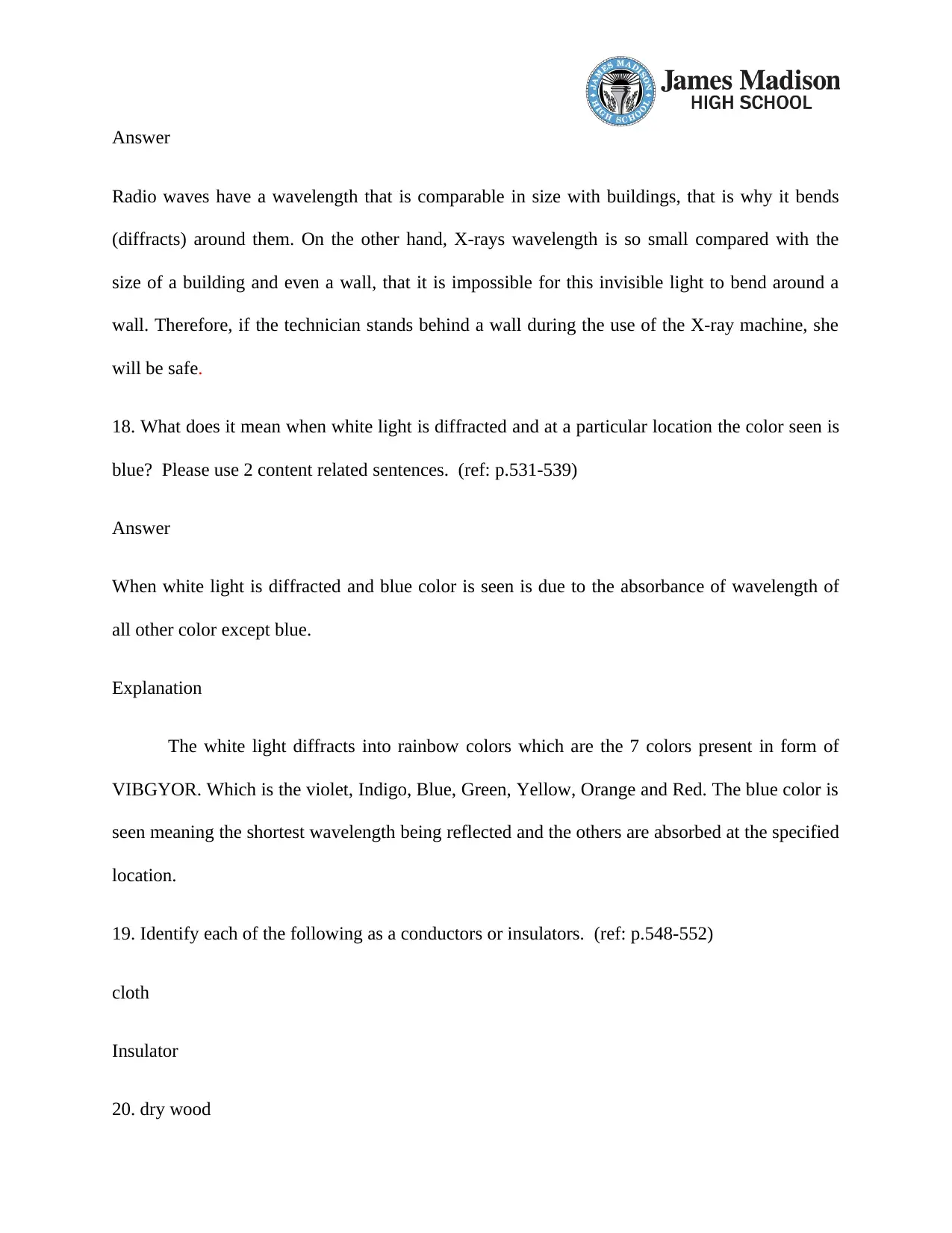
Answer
Radio waves have a wavelength that is comparable in size with buildings, that is why it bends
(diffracts) around them. On the other hand, X-rays wavelength is so small compared with the
size of a building and even a wall, that it is impossible for this invisible light to bend around a
wall. Therefore, if the technician stands behind a wall during the use of the X-ray machine, she
will be safe.
18. What does it mean when white light is diffracted and at a particular location the color seen is
blue? Please use 2 content related sentences. (ref: p.531-539)
Answer
When white light is diffracted and blue color is seen is due to the absorbance of wavelength of
all other color except blue.
Explanation
The white light diffracts into rainbow colors which are the 7 colors present in form of
VIBGYOR. Which is the violet, Indigo, Blue, Green, Yellow, Orange and Red. The blue color is
seen meaning the shortest wavelength being reflected and the others are absorbed at the specified
location.
19. Identify each of the following as a conductors or insulators. (ref: p.548-552)
cloth
Insulator
20. dry wood
Radio waves have a wavelength that is comparable in size with buildings, that is why it bends
(diffracts) around them. On the other hand, X-rays wavelength is so small compared with the
size of a building and even a wall, that it is impossible for this invisible light to bend around a
wall. Therefore, if the technician stands behind a wall during the use of the X-ray machine, she
will be safe.
18. What does it mean when white light is diffracted and at a particular location the color seen is
blue? Please use 2 content related sentences. (ref: p.531-539)
Answer
When white light is diffracted and blue color is seen is due to the absorbance of wavelength of
all other color except blue.
Explanation
The white light diffracts into rainbow colors which are the 7 colors present in form of
VIBGYOR. Which is the violet, Indigo, Blue, Green, Yellow, Orange and Red. The blue color is
seen meaning the shortest wavelength being reflected and the others are absorbed at the specified
location.
19. Identify each of the following as a conductors or insulators. (ref: p.548-552)
cloth
Insulator
20. dry wood
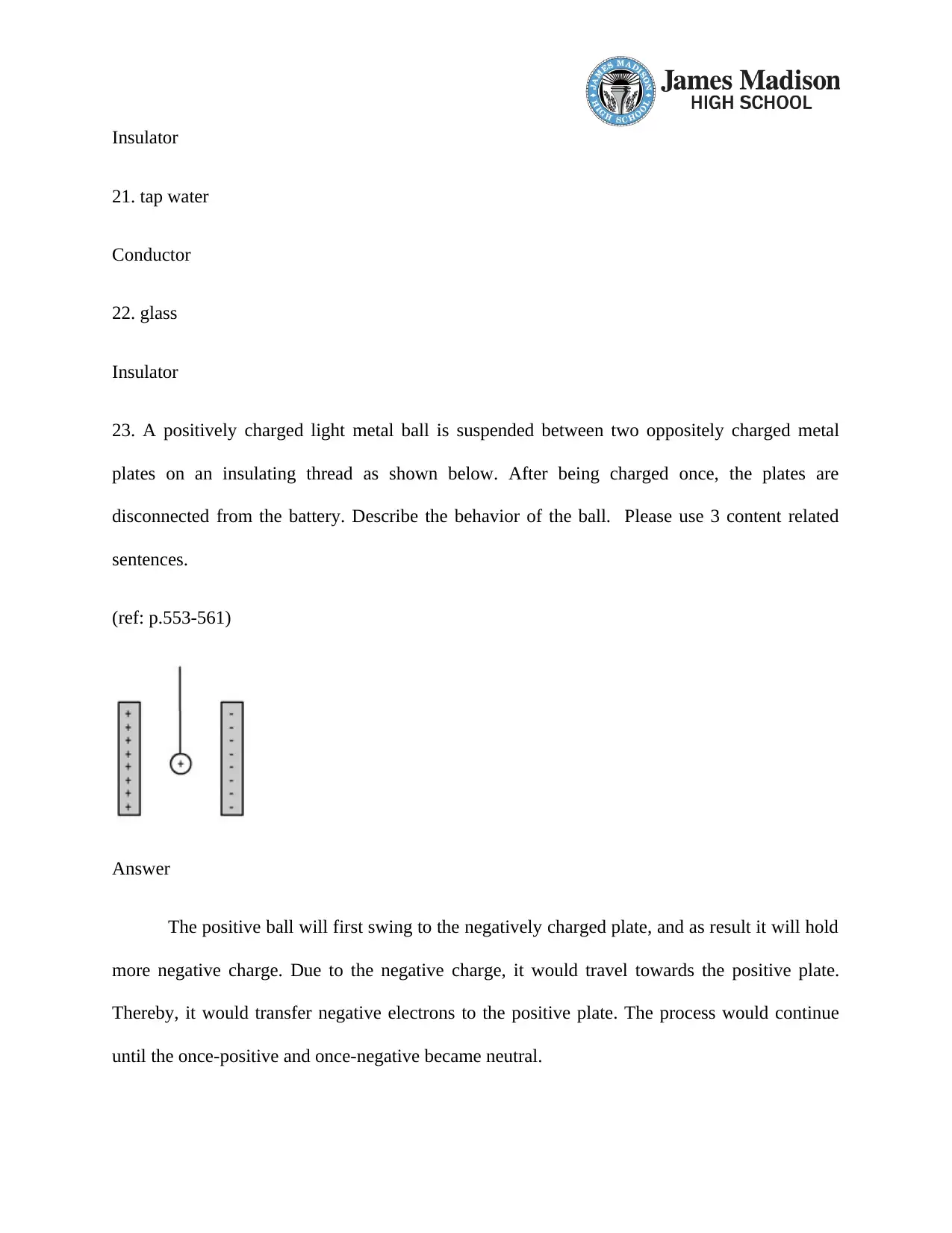
Insulator
21. tap water
Conductor
22. glass
Insulator
23. A positively charged light metal ball is suspended between two oppositely charged metal
plates on an insulating thread as shown below. After being charged once, the plates are
disconnected from the battery. Describe the behavior of the ball. Please use 3 content related
sentences.
(ref: p.553-561)
Answer
The positive ball will first swing to the negatively charged plate, and as result it will hold
more negative charge. Due to the negative charge, it would travel towards the positive plate.
Thereby, it would transfer negative electrons to the positive plate. The process would continue
until the once-positive and once-negative became neutral.
21. tap water
Conductor
22. glass
Insulator
23. A positively charged light metal ball is suspended between two oppositely charged metal
plates on an insulating thread as shown below. After being charged once, the plates are
disconnected from the battery. Describe the behavior of the ball. Please use 3 content related
sentences.
(ref: p.553-561)
Answer
The positive ball will first swing to the negatively charged plate, and as result it will hold
more negative charge. Due to the negative charge, it would travel towards the positive plate.
Thereby, it would transfer negative electrons to the positive plate. The process would continue
until the once-positive and once-negative became neutral.
⊘ This is a preview!⊘
Do you want full access?
Subscribe today to unlock all pages.

Trusted by 1+ million students worldwide
1 out of 23
Your All-in-One AI-Powered Toolkit for Academic Success.
+13062052269
info@desklib.com
Available 24*7 on WhatsApp / Email
![[object Object]](/_next/static/media/star-bottom.7253800d.svg)
Unlock your academic potential
Copyright © 2020–2025 A2Z Services. All Rights Reserved. Developed and managed by ZUCOL.